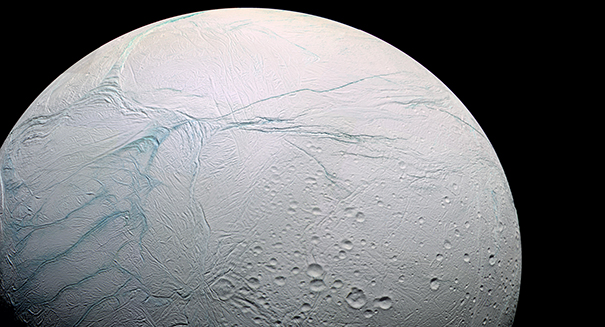
Scientists used the Cassini spacecraft to take a close look at a mysterious plume from the surface of Saturn's moon, and found something very surprising.
The water found in a geyser-like plume on Saturn’s moon Enceladus has a composition similar to waters here on Earth, raising hope among scientists that it could harbor life.
Researchers were able to learn about the pH level of the water coming from a plume on Eceladus based on research by a team from Carnegie Mellon University led by Christopher Glein, which was attempting to see whether life could have ever existed on Saturn’s sixth-largest moon, a geologically active celestial body that scientists believe has a liquid water ocean beneath the its frozen surface, according to media reports. The findings were published in the journal Geochimica et Cosmochimica Acta.
This plume of water is believed to come from the hidden ocean, which was observed by the Cassini spacecraft as it vented from the south polar region of the moon.
Researchers collected mass spectrometry data of ice grains and gases in the plume using Cassini, and were able to develop a new chemical model that enabled them to estimate the ocean’s pH level, which tells them how acidic or basic the water is. Understanding this is key to understanding how things work below the moon’s surface, and therefore whether life could exist there.
The model shows that the ocean is salty, with its pH quite alkaline at 11 or 12, similar to that of ammonia. It is also about a salty as our oceans on Earth, althoug a high amount of sodium carbonate would probably make the ocean more typical to a soda lake like Mono Lake in California.
The high pH of the ocean appears to be caused by what is known as serpentinisation, which is an underwater geochemical process when rocks that are low in silica and high in magnesium and iron are brought to the ocean floor from the upper mantle of the inner planet, causing it to interact chemically with the surrounding water. This could occur on Enceladus when ocean water circulates through what appears to be a rocky core on the ocean’s floor.
This would also result in the creation of molecular hydrogen, which would additionally produce chemical energy that could support a biosphere deep in the ocean, since the moon doesn’t get much sunlight.
Scientists believe that this molecular hydrogen could single-handedly drive organic compounds like amino acids that could result in life, and even serve as food for that life, which could come in the form of organisms that produce methane.
It is this serpentinisation that makes Enceladus a new ideal candidate or life outside of Earth.
Enceladus, the sixth-largest moon of Saturn, was discovered all the way back in 1789 by William Herschel, a German-born British astronomer. Not much was known about it until two Voyager spacecraft paid it a visit in the early 1980s. Those spacecraft found that Enceladus is only 310 miles in diameter, which is just a tenth the size of Titan, Saturn’s largest moon.
The surface of Enceladus is covered in ice, with a surface temperature reaching only -198 degrees Celsius at noon, as it reflects nearly all the sunlight that strikes the surface. Its surface ranges from old, cratered regions to young terrains that are only 100 million years old, scientists believe.

Cassini-Huygens is an unmanned spacecraft that was sent specifically to orbit and observe the planet Saturn. It was launched in 1997 after nearly 20 years of development. It includes the Saturn orbiter — Cassini — and a probe that was sent to the moon Titan — Huygens — which landed on Titan in 2005. Cassini is the first space probe ti enter orbit of Saturn, although it is the fourth spacecraft to visit the ringed planet.
NASA first reported evidence of a large underground ocean on Enceladus back in April 2014, a decade after first entering orbit with Saturn. The finding makes Enceladus one of the most promising places in the Solar System for the discovery of microbial life.
The Huygens probe was an atmospheric entry probe that landed successfully on Titan that was built and operated by the European Space Agency. It was named after Christiaan Huygens, a Dutch astronomer from the 17th century. Huygens discovered Titan in 1655.
Huygens separated from the Cassini orbiter on Christmas Day in 2004, landing on Titan a few weeks later, the first landing ever accomplished in the outer Solar System. It was built to handle both land and ocean when it landed, and it ended up touching down on land. It gathered data for a few hours in the atmosphere as well as a short period of time on the surface, sending data back 90 minutes after it first landed before shutting down for good. It remains the farthest humankind has ever landed a spacecraft.
Saturn is the sixth planet from our sun, and the second largest in the Solar System after Jupiter. It is a gas giant and it has a radius about nine times larger than Earth, although it has only one-eighth of the density. It is, however, 95 times more massive than Earth due to its much greater volume despite its low density.
Saturn has 150 moons and moonlets, and 53 of them have names. Titan is the largest and comprises more than 90 percent of the total mass of all the moons and everything else orbiting it — including the rings around Saturn. Rhea is the second largest moon.
Most of the moons are small, with 34 less than 10 kilometers in diameter, and another 14 less than 50 kilometers in diameter. Titan is the only moon that appears to have a significant atmosphere or any complex organic chemistry. Scientists believe that it’s possible that there is life on Titan as well, based on the detection in 2013 of polycyclic aromatic hydrocarbons in the upper atmosphere.